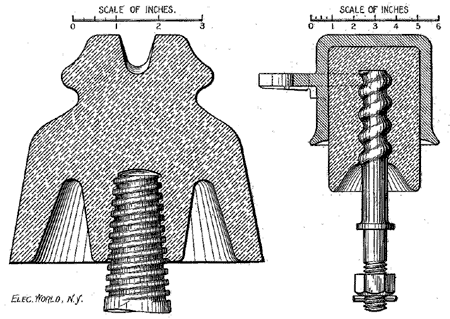[Trade Journal]
Publication: Electrical World
New York, NY, United States
vol. XXXI, no. 11, p. 341, col. 1-2
A New Insulating Material.
An organic insulating material of very high resistance has been developed and is now being put on the market by the Etho Carbon Crete Insulator Company, 44 Broad Street, New York. This material, which has been in use for underground piping, etc., for many years, is composed of various insulating substances, bound together with asphalt, and moulded into appropriate shapes under pressure. The tests of this material recently made with a high tension testing transformer of one of the large electrical companies show quite remarkable results as to its insulation resistance. The insulator for overhead wiring shown to scale in the accompanying cross section view, weighing 5 pounds, withstood a test of more than 100,000 volts alternating between the wire channel and the pin, at which pressure the discharge jumped over the surface around the petticoat, as it will do in any insulator of the same dimensions or even through free air. The insulator was not punctured at all even after this surface discharge, and there was no apparent carbonization of the material.
 |
| Etho Carbon Crete Insulators. |
The insulator appears to be quite non-hygroscopic, its surface when moulded under the pressure used (about 10 tons to the square inch for high tension work) having a high finish and apparently a slightly greasy nature, which prevents the deposition of moisture. One of the most valuable properties of the material, as compared with porcelain and glass, is its non-brittle character and its great strength. It has shown in testing machines a tensile strength of from 600 to 700 pounds per square inch, and a compression strength of from 5000 to 6000 pounds per square inch. It withstands without injury sharp blows which chip and crack the more brittle inorganic insulators.
Another valuable application for this material is the construction of insulators for conduit roads, a model devised for use on the Metropolitan Street Railway lines of New York City being shown in the illustration. Its value in this work is augmented by the fact that it does not have to be cemented either to the cap or the pin, as does the porcelain insulator now customarily used. The pin is simply inserted in a proper position in the cap, and the material moulded within the one and around the other, fastening them rigidly together. The material is not only impervious to moisture and unaffected by atmospheric impurities or chemical agents in the soil, but resists the action even of strong inorganic acids. It is, therefore, valuable for the construction of conduits, and owing to its strength (which compares favorably with that of cement) it makes a highly satisfactory duct. By joining lengths of such tubing together with hot plastic material of the same composition, the conduit may be made continuous and highly insulating in itself. Pipes of this material have been in use for sixteen years, and show no physical or chemical change.
